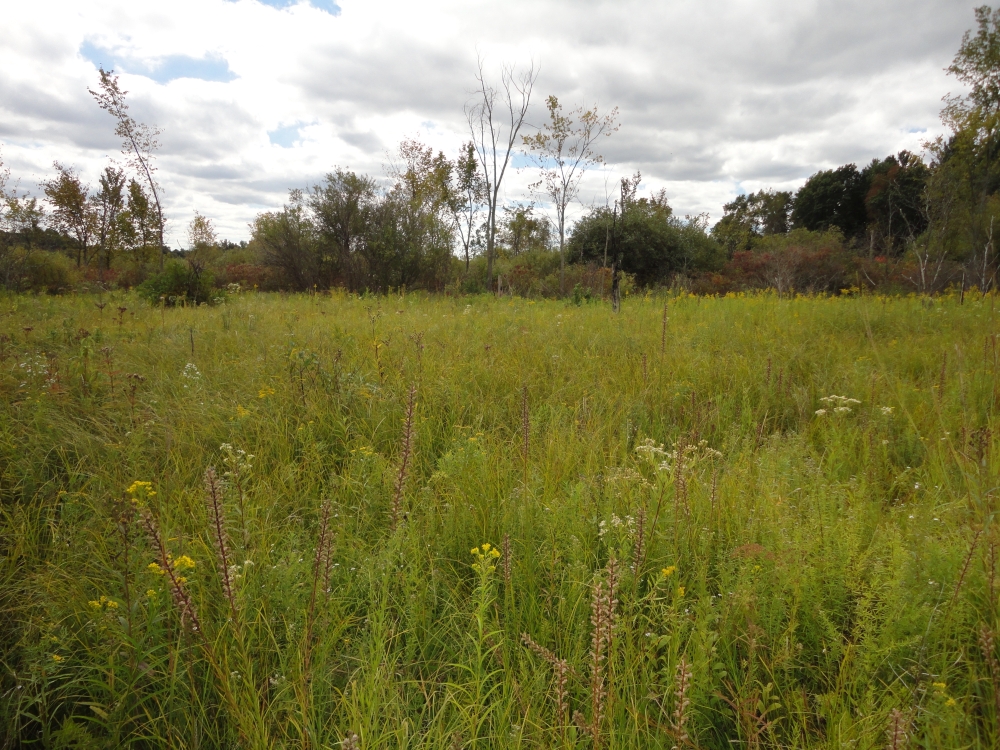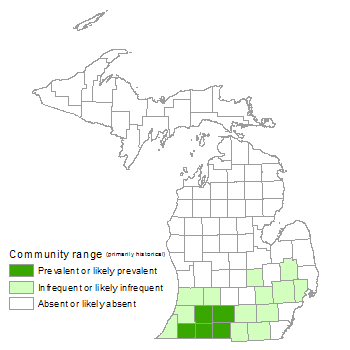Wet-mesic Prairie
Overview
Wet-mesic prairie is a native lowland grassland occurring on moist, occasionally inundated stream and river floodplains, lake margins, and isolated depressions in southern Lower Michigan. It is typically found on outwash plains and channels near moraines. Soils are primarily loam or silt loam with neutral pH and high organic content. Dominants or subdominants include big bluestem (Andropogon gerardii), Indian grass (Sorghastrum nutans), bluejoint grass (Calamagrostis canadensis), cordgrass (Spartina pectinata), and sedges (Carex spp.).
Rank
Global Rank: G2 - Imperiled
State Rank: S1 - Critically imperiled

Landscape Context
Wet-mesic prairie occurs on outwash plains and channels, typically near coarse-textured moraines, within stream or river floodplains, isolated depressions, and along lake margins. It is associated with uplands characterized by dry and dry-mesic southern forest, and prior to European settlement, oak savannas and prairie.
Soils
Soils are typically loam or silt loam and less frequently sandy loam, silty clay, or clay. Soils are characterized by neutral pH, with high organic content, and good water-retaining capacity. Organic deposits (muck) are absent or form only a thin layer over mineral soil.
Natural Processes
Water level fluctuations and fire help maintain diversity and open conditions. Seasonal saturation or inundation through flooding, ponding, or high water tables restricts shrub and tree establishment. Beaver can reduce shrub and tree cover by causing flooding, raising local water tables, and through herbivory. Prior to European settlement in the early 1800s, fires of natural and anthropogenic origin limited encroachment by shrubs and trees that established despite the unfavorable hydrologic conditions. Fire helps maintain species diversity by facilitating seed germination, opening microsites for seedling establishment and growth of small species, and releasing important plant nutrients that bolster plant growth, flowering, and seed set.
Vegetation
Dominant grasses are typically big bluestem and Indian grass, with bluejoint, cordgrass, and sedges (C. bebbii, C. stricta, etc.) often subdominant or common, especially in areas transitional to wet prairie. Other characteristic species include thimbleweed (Anemone virginiana), common horsetail (Equisetum arvense), rattlesnake-master (Eryngium yuccifolium, state threatened), grass-leaved goldenrod (Euthamia graminifolia), wild strawberry (Fragaria virginiana), northern bedstraw (Galium boreale), bottle gentian (Gentiana andrewsii), Virginia mountain mint (Pycnanthemum virginianum), yellow coneflower (Ratibida pinnata), black-eyed Susan (Rudbeckia hirta), prairie dock (Silphium terebinthinaceum), New England aster (Symphyotrichum novae-angliae), purple meadow rue (Thalictrum dasycarpum), and Culver’s root (Veronicastrum virginicum). Sites associated with prairie fen harbor calciphiles such as purple gerardia (Agalinis purpurea), fringed gentian (Gentianopsis crinita), Kalm’s lobelia (Lobelia kalmii), grass-of-Parnassus (Parnassia glauca), and shrubby cinquefoil (Dasiphora fruticosa). Common shrubs include silky dogwood (Cornus amomum), gray dogwood (C. foemina), red-osier dogwood (C. sericea), ninebark (Physocarpus opulifolius), and willows (Salix spp.); these may be dense due to fire suppression and/or hydrologic alteration. Diversity varies, in part depending on duration of seasonal inundation and time since last fire.
For information about plant species, visit the Michigan Flora website.
Plant Lists
Graminoids
- big bluestem (Andropogon gerardii)
- fringed brome (Bromus ciliatus)
- blue-joint (Calamagrostis canadensis)
- sedges (Carex bebbii, C. buxbaumii, C. pellita, C. stricta, and others)
- golden-seeded spike-rush (Eleocharis elliptica)
- little bluestem (Schizachyrium scoparium)
- Indian grass (Sorghastrum nutans)
- cordgrass (Spartina pectinata)
Forbs
- purple false foxglove (Agalinis purpurea)
- swamp agrimony (Agrimonia parviflora)
- thimbleweed (Anemone virginiana)
- white camas (Anticlea elegans)
- hedge bindweed (Calystegia sepium)
- swamp thistle (Cirsium muticum)
- rattlesnake-master (Eryngium yuccifolium)
- grass-leaved goldenrod (Euthamia graminifolia)
- wild strawberry (Fragaria virginiana)
- northern bedstraw (Galium boreale)
- bottle gentian (Gentiana andrewsii)
- fringed gentian (Gentianopsis crinita)
- marsh blazing-star (Liatris spicata)
- Kalm’s lobelia (Lobelia kalmii)
- wild bergamot (Monarda fistulosa)
- grass-of-Parnassus (Parnassia glauca)
- common mountain mint (Pycnanthemum virginianum)
- yellow coneflower (Ratibida pinnata)
- black-eyed Susan (Rudbeckia hirta)
- prairie dock (Silphium terebinthinaceum)
- goldenrods (Solidago gigantea, S. ohioensis, S. riddellii, and others)
- smooth aster (Symphyotrichum laeve)
- New England aster (Symphyotrichum novae-angliae)
- purple meadow-rue (Thalictrum dasycarpum)
- Culver’s root (Veronicastrum virginicum)
- golden alexanders (Zizia aurea)
Fern Allies
- common horsetail (Equisetum arvense)
Shrubs
- dogwoods (Cornus spp.)
- shrubby cinquefoil (Dasiphora fruticosa)
- common juniper (Juniperus communis)
- ninebark (Physocarpus opulifolius)
- willows (Salix spp.)
Noteworthy Animals
Beaver can cause flooding that substantially alters wetland community structure, converting lowland shrub and forest systems to pond, emergent marsh, wet meadow, wet prairie, wet-mesic prairie, and wet-mesic sand prairie, depending on landscape position, soils, and depth and duration of flooding.
Rare Plants
- Dodecatheon meadia (shooting star, state endangered)
- Eryngium yuccifolium (rattlesnake-master, state threatened)
- Mimulus alatus (wing-stemmed monkey-flower, presumed extirpated from Michigan)
- Polemonium reptans (Jacob’s ladder, state threatened)
- Polygala incarnata (pink milkwort, presumed extirpated from Michigan)
- Pycnanthemum muticum (broad-leaved mountain mint, state threatened)
- Rudbeckia subtomentosa (sweet coneflower, presumed extirpated from Michigan)
- Scleria triglomerata (tall nut-rush, state special concern)
- Silphium integrifolium (rosinweed, state threatened)
- Sisyrinchium farwellii (Farwell’s blue-eyed-grass, presumed extirpated from Michigan)
Rare Animals
- Ammodramus savannarum (grasshopper sparrow, state special concern)
- Asio flammeus (short-eared owl, state endangered)
- Botaurus lentiginosus (American bittern, state special concern)
- Circus cyaneus (northern harrier, state special concern)
- Clemmys guttata (spotted turtle, state threatened)
- Clonophis kirtlandii (Kirtland’s snake, state endangered)
- Dorydiella kansana (leafhopper, state special concern)
- Elaphe o. obsoleta (black rat snake, state special concern)
- Emydoidea blandingii (Blanding’s turtle, state special concern)
- Meropleon ambifusca (Newman’s brocade, state special concern)
- Neoconocephalus lyristes (bog conehead, state special concern)
- Neoconocephalus retusus (conehead grasshopper, state special concern)
- Neonympha m. mitchellii (Mitchell’s satyr, federal/state endangered)
- Orphulella pelidna (green desert grasshopper, state special concern)
- Papaipema cerina (golden borer, state special concern)
- Papaipema maritima (maritime sunflower borer, state special concern)
- Papaipema speciosissima (regal fern borer, state special concern)
- Sistrurus c. catenatus (eastern massasauga, federal candidate species and state special concern)
- Spartiniphaga inops (spartina moth, state special concern)
- Spiza americana (dickcissel, state special concern)
- Tyto alba (barn owl, state endangered)
Biodiversity Management Considerations
The majority of wet-mesic prairie acreage was converted to agriculture following European settlement. Threats to remaining sites include hydrologic alteration, nutrient enrichment, siltation, fire suppression, tree and shrub encroachment, and destruction of upland buffers. Fire suppression and hydrologic alterations such as ditching and drain tiling promote shrub and tree invasion, which reduces graminoid cover and the fine fuels capable of carrying a fire. Invasive plants are favored by nutrient enrichment, fire suppression, and hydrologic alteration. Invasive species include glossy buckthorn (Frangula alnus), common buckthorn (Rhamnus cathartica), multiflora rose (Rosa multiflora), autumn olive (Elaeagnus umbellata), reed (Phragmites australis subsp. australis), reed canary grass (Phalaris arundinacea), narrow-leaved cat-tail (Typha angustifolia), hybrid cat-tail (T. xglauca), and purple loosestrife (Lythrum salicaria). Prescribed fire, in conjunction with cutting and/or herbiciding of invasive species, should be considered to maintain the biodiversity of lowland grasslands. Some sites may require hydrologic restoration and efforts to restrict nutrient and sediment inputs. In addition, restoration of upland natural communities bordering wet prairie occurrences should be conducted to improve hydrology and provide refugia for flood-intolerant species during periods of high water.
Variation
Dominance varies among big bluestem, Indian grass, cordgrass, sedges, and native forbs. Some occurrences are associated with seasonal flooding, others apparently flood only rarely or not at all. Sites with bluejoint and/or cordgrass as dominants or subdominants may represent wet prairie. Occurrences associated with prairie fen show strong floristic influences of that community type, but wet-mesic prairies occupy mineral soil and prairie fens are found on organics soils.
Similar Natural Communities
Wet prairie, wet-mesic sand prairie, lakeplain wet-mesic prairie, lakeplain wet prairie, southern wet meadow, and prairie fen.
Places to Visit
- Hudson Mills Wet-mesic Prairie, Hudson Mills Metropark, Washtenaw Co.
- Indian Springs Wet-mesic Prairie, Indian Springs Metropark, Oakland Co.
- Pinckney Prairie, Pinckney State Recreation Area, Jackson Co.
- Williamsville Lake Prairie, Unadilla Wildlife Area, Livingston Co.
Relevant Literature
- Chapman, K.A. 1984. An ecological investigation of native grassland in southern Lower Michigan. M.A. thesis, Western Michigan University, Kalamazoo, MI. 235 pp.
- Galatowitsch, S.M., D.C. Whited, R. Lehtinen, J. Husveth, and K. Schik. 2000. The vegetation of wet meadows in relation to their land-use. Environmental Monitoring and Assessment 60: 121-144.
- Kercher, S.M., and J.B. Zedler. 2004a. Flood tolerance in wetland angiosperms: A comparison of invasive and noninvasive species. Aquatic Botany 80: 89-102.
- Kercher, S.M., and J.B. Zedler. 2004b. Multiple disturbances accelerate invasion of reed canary grass (Phalaris arundinacea L.) in a mesocosm study. Oecologia 138: 455-464.
- NatureServe. 2006. NatureServe Explorer: An online encyclopedia of life [Web application]. Version 6.1. NatureServe, Arlington, VA. Available http://www.natureserve.org/explorer. (Accessed: January 3, 2007.)
For a full list of references used to create this description, please refer to the natural community abstract for Wet-mesic Prairie.
More Information
Citation
Cohen, J.G., M.A. Kost, B.S. Slaughter, D.A. Albert, J.M. Lincoln, A.P. Kortenhoven, C.M. Wilton, H.D. Enander, and K.M. Korroch. 2020. Michigan Natural Community Classification [web application]. Michigan Natural Features Inventory, Michigan State University Extension, Lansing, Michigan. Available https://mnfi.anr.msu.edu/communities/classification. (Accessed: January 12, 2025).
Kost, M.A., D.A. Albert, J.G. Cohen, B.S. Slaughter, R.K. Schillo, C.R. Weber, and K.A. Chapman. 2007. Natural Communities of Michigan: Classification and Description. Michigan Natural Features Inventory, Report No. 2007-21, Lansing, MI.


